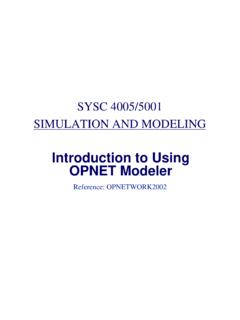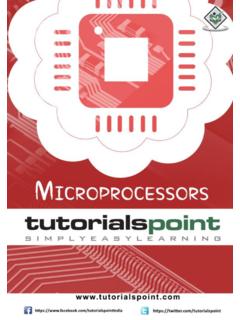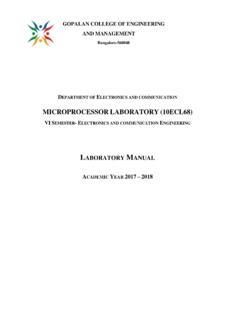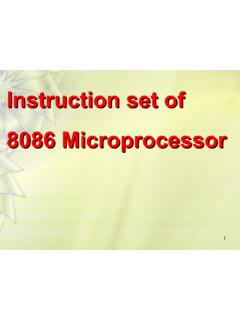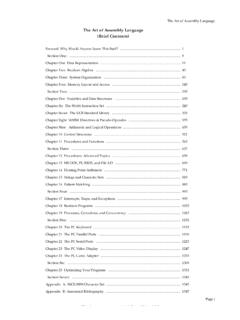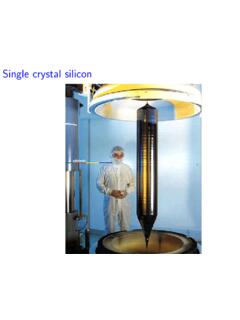Transcription of Introductory Assembly Language - Carleton
1 Introductory Assembly LanguageThorne : Chapter 3, Sections , , Appendix (Irvine, Edition IV : , , , , )SYSC30061 Intel 8086 Assembly InstructionsIntel 8086 Assembly Instructions Assembly instructions are readable forms of machine instructions They use mnemonicsto specify operations in a human-oriented short form ExamplesMOV(move)SUB(subtract)JMP(jump) Instructions have two aspects : operation and operands Operation (Opcode): how to use state variable values operands: which state variables to us Operands can be specified in a variety of ways that are called addressing modes Simple modes:register, immediate, directSYSC30062 More powerful:indirect Sample Instructions SyntaxSemanticsMOVAX, BXAX := BX(2 ops)ADDDX, CXDX := DX + CX(2 ops)SUBDX, AXDX := DX AX(2 ops)INCAXAX := AX + 1(1 op)NOP(0 op)Instructions with two operands : destination (dest), source (src)MOVAX,BXOperation operand (dest), operand (src)(Opcode)(Order of dest and src is important, Must know on exams)SYSC30063(p,)Instruction Syntax.
2 Operand Compatibility For all instructions with two operands, the two operands must be compatible (same size).In high level languages : type checking In high level languages : type checking In Assembly : same size Examples :MOVAH, CL8-bit src and dest MOVAL, CX????? /Example uses register modeExample uses register mode, but compatibility is required for all addressing modes to ModesgSyntaxSemanticsAddresssing ModeMOV AX, BXAX := BXRegister,RegisterADDDX, 1DX := DX + 0001 Register,ImmediateSUBDX, [1]DX := DX m[DS:0001] Register,Direct MemorySUBDX, varDX :=DX m[DS:var]Register,Direct MemoryA variable declared in data segment (more later)INC[BX]m[DS:BX]:= m[DS:BX]+1 Register IndirectMOV AX, [BX+1]AX := m[DS:BX+1]Based Indirectdddig()MOV AX, [BX+SI]AX := m[DS.]
3 BX+SI]Based-Index IndirectMOV AX, [BX+SI+1] AX := m[DS:BX+SI+1]Based-Index Indirectwith DisplacementSYSC30065pAddressing Mode : (1) RegisterRegister modeallows a register to be specified as an operandAs a source operand : Instruction will copyregister valueAd ti tiitlti tAs a destination:write value to registerExample:MOV AX, DXregister addressing mode for both dest and srcp,AX := DXContents of DX is copied to AXSYSC30066 Addressing Mode : (2) ImmediateAddressing Mode : (2) Immediate Immediate modeallows a constantto be specified as source Constant value is encodedas part of the instruction Eample:MOVAL 5 Example: MOVAL, 5 Because AL is an 8-bit destination, the instruction encoding includes 8-bit value 05h Example: MOV AX, 5 Because AX is a 16-bit destination, the instruction encoding includes the 16-bit value 0005hincludes the 16bit value 0005h Question: Is this possible ?
4 MOV4, BH ????SYSC30067 Addressing Mode : (3) Direct Memory Direct memory modeallows the address offsetof a memory variable to be specified as an operandvariable to be specified as an operand A constant address offsetis encoded as part of the instruction The address offset is static: It must be known at Assembly -time and remains constant through executionbut thetime and remains constant through execution .. but the contentsof that address may be dynamic During execution, the address offset is implicitlycombined withDSwith DS Example:MOV AL, [5] Reads contents of byte at address DS:0005 BEWARE : Compare To Example:MOV var, AX Assumes a variable is declared in data segment Write contents of word at address DS:var Compare To Immediate Mode!
5 !MOV AL, 5 SYSC30068 Addressing Mode : (4a) Register Indirect A register holds the address offset of the operand The register can only be :BX SI DI BP The register can only be : BX, SI, DI, BP DSis default segment for: BX, SI, DI SSis default segment for BP(later!) Syntax : [ register ]Idi tElVa l u e i n B Xis used as address Indirect Example:MOV AX, [ BX ]= MOV AX, DS:[BX]Va l u e in BXis used as address offset to a memory operandCPU loads AX with contents of,[] AX:= m[DS:BX]CPU loads AX with contents of contents of that memoryIndirect addressing mode use registers as a pointer, hi h ii tt h dl!
6 (l t )SYSC30069which is a convenient way to handle an array! (later)Addressing Mode : (4b) Indirect Indexed or Based Like register indirect, except you also specify a [ BX + constant ] During execution, the processoruses a temporary register to calculate BX + constant It then accesses memory addressed by BX + constantyy Restriction: may only use BP, BX, SI or DI Example : same as register indirectMOV AX, [ BX +2 ]= MOV AX, 2[BX]=MOV AX [BX][2]In both cases : CPU computes address = Value in BX+2 MOV AX, [BX][2]MOV AX, [ BX +var ]BX+2 CPU loads AX with of that addressSYSC300610= MOV AX, var[BX] Addressing Mode (4c) : IndirectBased-IndexedAddressing Mode (4c) : Indirect BasedIndexed It is like indexed, except you use a second register instead of a [ BX + SI ] During execution, the processoruses a temporary register to calculate sum of register values It then accesses memory addressed by sum Restrictions: one must be base register: BX (or BP later!)
7 One must be index register: SI or DI The only legal forms: [ BX + SI ][ BX + DI ]base = BXDefault DS[][][ BP + SI ][ BP + DI ]base = BPDefault SSSYSC300611 Addressing Mode (4c) :IndirectBasedIndexed withAddressing Mode (4c) : Indirect Based-Indexed with Displacement It is like based-indexed mode, except includes a constant too, [ BX + SI + constant ] During execution, the processoruses a temporary register to calculate sum of valuescalculate sum of values It then accesses memory addressed by sum Restrictions: same as based mode MOVAX, [ BX + SI + 2 ]= MOV AX, [BX][SI+2]=MOVAX 2[BX+SI]In both cases : CPU computes address=Va l u e i n= MOVAX, 2[BX+SI] MOVAX, [ BX + SI + var ]CPU computes address Va l u e in BX+SI+2 CPU loads AX with of that addressSYSC300612= MOVAX, var[BX][SI]Loading Registers with Addresses Before most instructions that use indirect addressing, the registers have to be loaded with address.
8 Two alternatives :MOVBX, OFFSETW Functionally equivalent!LEABX, W Both calculate and load the 16-bit effective address of a memory OverrideRequired for exam : Restricted uses of registersMOV [DX], AXMarks will be :DSis default segment for: BX, SI, DISSis default segment for BP(later!)MOV [BX], AL = =MOV DS:[BX], ALMOV [BP], AL = =MOV SS:[BP], ALAt times, you may run out of registers and need to use either the index registers or the segment registers outside of their assigned default roles (eg. duplicating data structures),default roles (eg. duplicating data structures),MOV SS:[BX], ALMOV ES:[BX], ALMOV DS [BP] ALSYSC300614 MOV DS:[BP], ALOperand Compatibility with Memory OperandsClear and unambiguousExamplesMOV [0 BCh], AXMOV [BX] ALMOV [BX], AL Why ?
9 Because the other REGISTER operand determines sizeAmbiguousExamples : MOV [0 BCh], 1 MOV [BX], 0 Why ? The immediate operand could be 8 bitsor 16 bits? How does the assembler decide ?SYSC300615 How does the assembler decide ?Operand Compatibility with Memory Operands Memory Access QualifiersWORD PTRword pointer 16-bit operandWORD PTRword pointer 16-bit operandBYTE PTRbyte pointer 8-bit operandl Example : MOV BYTE PTR[0FF3E], 18 bit destination, no ambiguitygyMOV WORD PTR[BX], 016bit destination no ambiguitySYSC30061616-bit destination, no ambiguity Assembler Tip About Operand Compatibility WDW0AA33h.
10 MOVAL W8bitregister dest operand16-bitmemory src operandMOVAL, W The assembler will generate an error8-bitregister dest operandg Basic type checking SYSC300617 Programs to do simple arithmeticPrograms to do simple arithmeticProblem: Write a code fragmentto add the values of memory locations at DS:0, DS:01, and DS:02, and save the result at :Step 1 AL m[DS:00]ProcessorMemoryStep 2AL AL + m[DS:01]Step 3AL AL +[DS 02]AL=10h/30h/44hDS:0010hDS:0120hAL AL + m[DS:02]Step 4DS:10 ALDS:0214hMOV AL, [0000]ADD AL, [0001]ADD AL, [0002]DS:10hFFh 44hDSis default!

